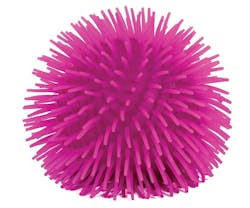The Power of Play
The sight of a group of Google product designers throwing around a Koosh ball while brainstorming is as much aspirational as it is inspirational. By asking ourselves how we stay inspired, we are really asking, “What is the secret to success?”
Consider Inside the Actors Studio or The Paris Review “Writers at Work” series—or that “finding creative inspiration” turns up about 6.7 million Google results in half a second. Charting a creative professional’s work process—from asking early influences to “what turns you on”—is a curiosity we like to indulge.
Perhaps when each of us hits a wall, we think, If a famous musician goes to local shows four to five nights a week or this Oscar-award winning screenwriter takes a shower every time he hits a wall, then it must work!
Here is what keeps a few select IIDA members going:
- Sascha Wagner, IIDA, CID, LEED AP ID+C, president and CEO of Huntsman Architectural Group: “I travel, read, eat and drink, sketch, watch films, listen to music, and try to spend time with interesting people. I make an effort to go outside more, exercise, or just take a walk and observe. I get inspiration from just about everything, so for me it’s about staying receptive. Of course I try to carve out some quiet time to be reflective as well. These days that usually happens on airplanes.”
- Brian Graham, IIDA, IDSA, creative director of Graham Design LLC: “Inspiration for me comes in many forms. Modern architecture is a constant and never-ending source of visual inspiration for my work. Personally, musicians, athletes, and filmmakers—really anyone who’s already been labeled ‘great’ yet challenges themselves to grow, develop, and become better—remind me to try to do the same.”
- Alison Kennedy, IIDA, interior designer at Booz Allen Hamilton: “Professionally, I open myself to new influences and cutting-edge approaches in design. I am constantly looking to reinvigorate my design process. Personally, I look for design in everything I see. I can appreciate both what an object is and what it could be.”
From the simple act of eating and drinking to athletes, filmmakers, and objects, design inspiration is found everywhere—and so are the secrets to success, as long as we are open to pushing ourselves to be better.
In finding inspiration, I am reminded of the growing scientific research that supports the importance of play not only in early childhood, but in adulthood. Dr. Stuart Brown, founder of nonprofit organization the National Institute for Play, which advocates for expanding clinical scientific knowledge of human play and bringing public attention to its benefits, defines play as “apparently purposeless activity that’s fun to do and pleasurable.” The institute reports that play optimizes learning, boosts the harmony and effectiveness of relationships, and increases the innovation of workgroups. In other words, play sharpens the mind, encourages empathy, and invites new ideas.
By its nature, play promotes insight, dexterity, and adaptability—which are, incidentally, prerequisites for creating strong interior design. As Wagner puts it, “Most design is essentially about the human experience. Specifically, interior design focuses on the emotional
impact of built environments and embodies many essential aspects of architecture, industrial design, graphics, and other creative fields. These arts are all part of exploring how people engage with spaces, things you perceive and feel.”
Good interior design plays well with other sectors of design and successful designers understand that. Adds Kennedy, “A successful interior designer must be sensitive to both the tangible and intangible aspects. Particular attention must be paid to construction, ergonomics, workflow, and human interaction sensibilities. Knowing this informs a holistic, three-dimensional work product that tends to meet the designer’s challenge and the client’s expectations.”
Make recess part of your process. Find inspiration outside of your discipline. Push yourself to be a better designer and, by extension, person—or in the words emblazoned on the side of the global advertising agency TBWA\Chiat\Day Los Angeles’s office, “Be more human (and if in doubt) be more dog.”
Genny Ramos is a communications strategist at IIDA headquarters in Chicago. She can be contacted at [email protected].
